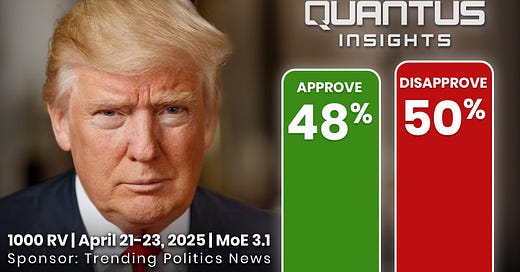Split Nation, Unready Party: The Strategic Drift of 2025
Our latest naitonal survey reveals a data portrait of voter alignment, party fracture, and the early tremors of 2028
I. A Nation Divided—but Not in Doubt
Donald J. Trump begins his second term with the country split—but not evenly, and not softly. According to our latest survey of 1,000 registered voters, conducted April 21–23, the American electorate remains sharply polarized on both the man and the moment (SEE CROSSTABS HERE).
Trump’s job approval stands at 47.7% approve, 49.8% disapprove. His favorability numbers run almost identical: 46.8% favorable, 49.3% unfavorable. These are not margin-of-error disputes. This is trench warfare politics—hardened, habitual, and unmoved by noise.
But beneath the surface lies a key point: Trump’s support is firmer, his opposition broader. He holds 91% approval among Republicans. Among Independents, he splits the room—41% approve, 53% disapprove. That’s not collapse. That’s a country making up its mind again, not for the first time.
II. War and the Weight of Command
On the matter of foreign affairs, particularly the war between Russia and Ukraine, Trump’s approval dips slightly—45.3% approve, 50.7% disapprove. A majority of voters, 63%, say they would hold Trump at least partially responsible if the war worsens. But should peace arrive, 67% say he would deserve at least some credit.
These are not the numbers of a president losing his grip. They are the numbers of a president held to a higher standard. Trump is not graded on a curve—he’s graded on expectation, performance, and consequence. Americans may not like the man, but they are watching him. And when it comes to foreign war and peace, the electorate remains deeply invested in the outcome, not just the optics.
III. The Democratic Party: No Consensus, No Commander
If Trump’s standing is steady, the same cannot be said of his opposition. Among Democrats and Democratic-leaning Independents, our oversample reveals a party not fractured by ideology, but directionless in leadership.
Kamala Harris leads the 2028 primary field with just 30%—a modest advantage, not a mandate.
No candidate breaks out of the pack: AOC (14%), Buttigieg (13%), Booker (13%), Sanders (6%), Newsom (7%), Shapiro (5%), Walz (5%).
20% say “none of the above” or don’t know who represents the party’s values.
There is no Barack Obama figure on the horizon. No one commanding the stage. The party has gone from a chorus to cacophony—and the voters hear it.
IV. Left or Center? The Internal Cold War
Perhaps the most defining tension: 50% want the Democratic Party to move toward the center. The other half want it to stay left—or move further. The divide is ideological, generational, and geographic.
32% say the party is already too progressive.
22% say it’s not progressive enough.
46% say it’s about right.
That’s not a majority—it’s a balancing act. One that can’t hold forever. The party must choose: chart a course or drift.
V. Strategy Toward Trump: Resist or Engage?
When asked how Democrats should deal with Trump in office:
49% say resist.
41% say work with him.
10% are unsure.
Even the resistance isn’t absolute anymore. Economic pressures and cultural fatigue are nudging Democratic voters to consider cooperation. Not because they support Trump—but because they’re tired of losing ground.
VI. The Big Picture: A Party Without a Plan, a President Without Forgiveness
The Democratic Party has energy. What it lacks is unity, direction, and a compelling leader to harness it. Trump, on the other hand, commands loyalty from his base, skepticism from the middle, and rage from his critics. But he is not fading.
The numbers show this clearly: Trump is not adored, but he is known. He is not liked by all—but he is trusted by enough. The Democrats? They are liked by some, but trusted by fewer—and led by no one.
In American politics, absence of leadership is more fatal than presence of controversy. Right now, one side has a name. The other has a list.
Conclusion: A Quiet Electoral Storm
This is not a moment of calm. It is a moment of stasis before disruption. Approval is soft, but allegiance is hardening. The public mood is skeptical, not sleepy. The road to 2026, let alone 2028, runs through economic reality, foreign uncertainty, and a Democratic Party searching for its voice.
The center may still hold—but only just.




